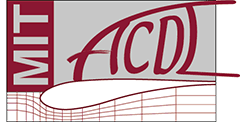A computational technology for optimal automatic design of aerodynamic shapes, developed by the authors, is described and applied to multi-point design of an industrial aircraft configuration. . The objective is to minimize the total drag at fixed lift subject to various geometrical and aerodynamic constraints. The code employs Genetic Algorithms (GAs) as an optimization engine in combination with a Reduced-Order Models (ROM) method, based on linked local data bases obtained by full Navier-Stokes computations.
The important features of the computational technology include:
- Robust handling of up to 100 independent and interrelated design constraints
- Use of highly accurate full Navier-Stokes computations as a driver of optimization stream
- PVM driven multilevel parallelization on multiprocessor cluster
- Extremely high level of computational efficiency, which allows to access industrial solutions on a daily basis
- High robustness based on an unique fault-tolerance treatment
The CFD driver is a multiblock-multigrid code, which employs structured point-to-point matched grids and the Essentially Non-Oscillatory (ENO) numerical scheme, allows to attain high accuracy Navier-Stokes solutions on relatively coarse grids, and it is highly robust for a wide range of flows and geometrical configurations.
The applications include single- and multi-point aerodynamic design for a transport-type aircraft configuration. For the considered class of shape optimizations (3D isolated wings, wing-body, wing-body-nacelle), significant drag reduction in on- and off-design conditions has been achieved. It was also shown that the optimizations which start from markedly different initial shapes ultimately converge to optimum shapes very close one from another. The presented results indicate the applicability of the method to practical aircraft design due to its accuracy, robustness and computational efficiency.
Co-authored with Boris Epstein

